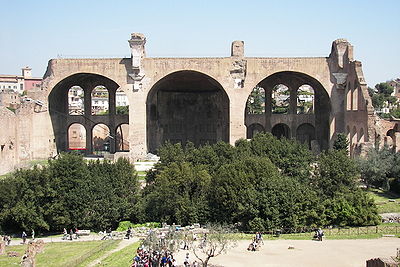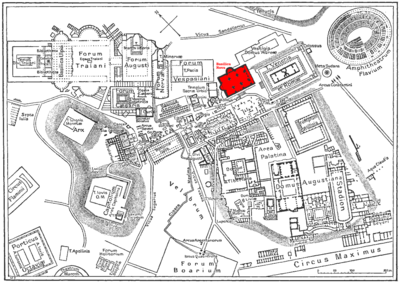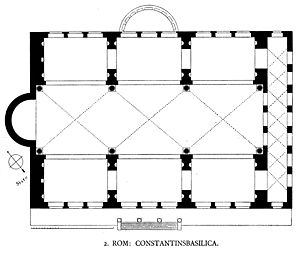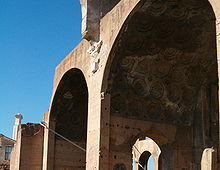- Basilica of Maxentius
-
Coordinates: 41°53′30″N 12°29′18″E / 41.891775°N 12.488446°E
Remains of the Basilica of Maxentius and Constantine. The building's northern aisle is all that remains.
The Basilica of Maxentius and Constantine (sometimes known as the Basilica Nova - meaning "new basilica" - or Basilica of Maxentius) is an ancient building in the Roman Forum, Rome, Italy. It was the largest building in the Forum.
Contents
History
Construction began on the northern side of the forum under the emperor Maxentius in 308, and was completed in 312 by Constantine I after his defeat of Maxentius at the Battle of the Milvian Bridge.[1]
The building consisted of a central nave covered by three groin vaults suspended 39 meters above the floor on four large piers, ending in an apse at the western end containing a colossal statue of Constantine (remnants of which are now in a courtyard of the Palazzo dei Conservatori of the Musei Capitolini). The lateral forces of the groin vaults were held by flanking aisles measuring 23 by 17 metres (75 x 56 feet). The aisles were spanned by three semi-circular barrel vaults perpendicular to the nave, and narrow arcades ran parallel to the nave beneath the barrel vaults. The nave itself measured 25 metres by 80 metres (83 x 265 feet) creating a 4000 square meter floor. Like the great imperial baths, the basilica made use of vast interior space with its emotional effect.
Running the length of the eastern face of the building was a projecting arcade. On the south face was a projecting (prostyle) porch with four columns (tetrastyle).
The south and central sections were probably destroyed by the earthquake of 847. [2] All that remains of the basilica is the north aisle with its three concrete barrel vaults.[1] The ceilings of the barrel vaults show advanced weight-saving structural skill with octagonal ceiling coffers. The wrestling events were held here during the 1960 Summer Olympic Games.
In ancient Rome a basilica was a rectangular building with a large central open space, and often a raised apse at the far end from the entrance. Basilicas served a variety of functions, including a combination of a court-house, council chamber and meeting hall. There might be, however, numerous statues of the gods displayed in niches set into the walls. Under Constantine and his successors this type of building was chosen as the basis for the design of the larger places of Christian worship, presumably as the basilica form had fewer pagan associations than those of the designs of traditional Greco-Roman temples, and allowed large congregations. As a result of the building programmes of the Christian Roman emperors the term basilica later became largely synonymous with a large church or cathedral.
The color of the building before it was destroyed was white. On the outside wall of the basilica, facing onto the via dei Fori Imperiali, are contemporary maps showing the various stages of the rise of the Roman Empire which were added during the Fascist regime of Benito Mussolini. A map depicting Mussolini's "New Roman Empire" was removed from the wall after the war.
Engineering
The Basilica Maxentius is a marvel of Roman engineering work. At the time of construction, it was the largest structure to be built and thus is a unique building taking both aspects from Roman baths as well as typical Roman basilicas. At that time, it used the most advanced engineering techniques known including innovations taken from the Markets of Trajan and the Baths of Diocletian.
Similar to many basilicas at the time such as the Basilica Ulpia, the Basilica Maxentius featured a huge open space in the central nave, but unlike other basilicas instead of having columns support the ceiling the entire building was built using arches, a much more common appearance in Roman baths than basilicas. Another difference from traditional basilicas is the roof of the structure. While traditional basilicas were built with a flat roof, the Basilica Maxentius was built with a folded roof, decreasing the overall weight of the structure and decreasing the horizontal forces exerted on the outer arches.[3]
See also
- Colossus of Constantine, originally situated in the west apse of the Basilica.
References
- ^ a b Roth, Leland M. (1993). Understanding Architecture: Its Elements, History and Meaning (First ed.). Boulder, CO: Westview Press. pp. 30, 222. ISBN 0-06-430158-3.
- ^ René Seindal "Basilica of Maxentius - the last and largest basilica in the Roman Forum", Photo Archive, 2003-08-06, accessed November 7, 2010.
- ^ Giavarini, Carlo., The Basilica of Maxentius: the Monument, its Materials , Construction, and Stability, Roma: L'Erma di Bretschneider, 2005.
Sources
- 1960 Summer Olympics official report. Volume 1. pp. 76, 79.
- The Roman Empire: From the Etruscans to the Decline of the Roman Empire, Henri Stierlin, TASCHEN, 2002, Edited by Silvia Kinkle, Cologne, ISBN 3-8228-1778-
External links
 Media related to Basilica of Maxentius at Wikimedia Commons
Media related to Basilica of Maxentius at Wikimedia Commons- A reconstruction at the Plan de Rome
Venues of the 1960 Summer Olympics Acqua Santa Golf Club Course · Arch of Constantine · Basilica of Maxentius · Baths of Caracalla · Campo Tre Fontane · Cesano Infantry School Range · Florence Communal Stadium · Grosetto Communal Stadium · Gulf of Naples · L'Aquila Communal Stadium · Lake Albano · Lazio Pigeon Shooting Stand · Livorno Ardenza Stadium · Naples Saint Paul's Stadium · Olympic Velodrome · Palazzo dei Congressi · Palazzo dello Sport · Palazzetto dello sport · Passo Corese · Pescara Adriatic Stadium · Piazza di Siena · Piscina delle Rose · Pratoni del Vivaro · Raccordo Anulare · Stadio dei Marmi · Stadio Flaminio · Stadio Olimpico · Stadio Olimpico del Nuoto · Umberto I Shooting Range · Via Appia Antica · Via Cassia · Via Flaminia · Via Cristoforo Colombo · Via di Grottarossa1896: Panathinaiko Stadium • 1904: Francis Field • 1908: White City Stadium • 1912: Stockholm Olympic Stadium • 1920: Antwerp Zoo • 1924: Vélodrome d'hiver • 1928: Krachtsportgebouw • 1932: Olympic Auditorium • 1936: Deutschlandhalle • 1948: Empress Hall, Earl's Court, Harringay Arena • 1952: Messuhalli • 1956: Royal Exhibition Building • 1960: Basilica of Maxentius • 1964: Komazawa Gymnasium • 1968: Insurgentes Ice Rink • 1972: Messegelände, Judo- und Ringerhalle • 1976: Centre Pierre Charbonneau, Maurice Richard Arena • 1980: CSKA Athletics Fieldhouse • 1984: Anaheim Convention Center • 1988: Sangmu Gymnasium • 1992: Institut National d'Educació Física de Catalunya • 1996: Georgia World Congress Center • 2000: Sydney Convention and Exhibition Centre • 2004: Ano Liosia Olympic Hall • 2008: China Agricultural University Gymnasium • 2012: ExCeL • 2016: Olympic Training Center – Arena 3 Categories:
Categories:- 4th-century architecture
- Ancient Roman architecture
- Ancient basilicas in Rome
- 1960 Summer Olympic venues
- Olympic wrestling venues
Wikimedia Foundation. 2010.




